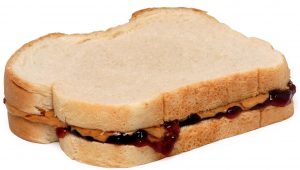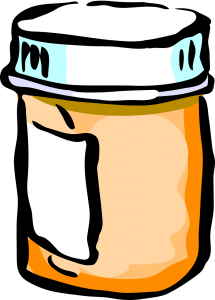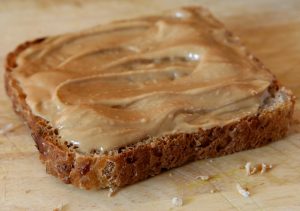Did you know that one of the first uses of peanut butter was as a protein source for a physician’s patients who had no teeth? “Lost your dentures again, Edgar? Here, have some peanut butter.”
“What’s that stuff?”
“Never mind. It’s good for you.”
ALONG CAME PEANUT BUTTER
Some credit WWII with introducing peanut butter to jelly, a marriage–as we well know–made in heaven. 
In its early days of commercial use, the Skippy brand had the corner on the market. Then Jif was introduced to the world, apparently named just enough differently from Skippy as to not cross trademark barriers. “I’ll be there in a skippy, or a jiffy.” We see what you did there, marketing geniuses.
A missionary returned from overseas and later reported his biggest meltdown upon re-entry. He’d stood in a modern grocery store, in the peanut butter aisle, frozen by the overwhelming options of varieties of peanut butter–creamy, chunky, extra-chunky, mega-chunky (otherwise known as peanuts), organic, no-stir natural, with the jelly swirled inside (which looks pretty in the jar but like a mud pit after a week of use), large, small, single-serving packets…
 The options proved so boggling that he walked out of the store without purchasing peanut butter.
The options proved so boggling that he walked out of the store without purchasing peanut butter.
And that…in a nutshell…explains why novelists have a hard time finding readers.
Thanks for stopping by. Have a great week.
Oh. You’d like to know the connection? Consider this.
PEANUT BUTTER AND FICTION
Today’s reader is a returning traveler standing in the peanut butter aisle. “SO MANY CHOICES! I…guess I’ll try…maybe the red one? No. There’s a pretty cover. Wait! That’s a brand I recognize. But so’s that one. Grrr! I probably should read healthier, so I’ll take the all-organic classic with the– No. I’m in the mood for something a little different. This one’s cheaper. Cheaper’s not always better. This one looks interesting. ‘Perfect for the discerning palate.’ Hmm. Maybe not. I don’t need fancy. Just something to read! I know. I’ll Google recommendations. Great. More than a million options. I think I’ll make a ham sandwich.”
Yes, the rumor is true. More than one million self-published books hit the market in 2017, and among those were hundreds of thousands of novels. Add in the traditionally published novels in that single year, plus all the books written in the past decades, plus the classics from previous centuries, and the options are nothing less than overwhelming.
ARE PEOPLE MIGRATING TO ALMOND BUTTER?
Several recent articles in industry publications have discussed falling fiction sales in the years 2013-2017. See this article in Publishers Weekly for opinions and observations on the trend. Of interest to authors are these points noted in the article, among others:
Fiction, more than nonfiction, depends on readers discovering new books by browsing. Now, with the number of physical stores down from five years ago…publishers cannot rely on bricks-and-mortar stores providing customers with access to new books.
Review space in mainstream media has been slashed, cutting off another possibility for readers to learn about new fiction.
Publishers have found breaking out new writers—never mind developing new franchise authors—increasingly difficult.
Creating authors who can draw readers via name recognition alone is crucial to selling novels. Research done by the Codex Group shows that the author is the most important factor in a person’s decision to buy a novel. Codex founder Peter Hildick-Smith says that with so much inexpensive genre fiction now available at “subprime price points under $5” (from such channels as Kindle Unlimited), publishers must invest to develop brand name authors who can command premium-price loyalty.
(Above quotes from “What’s the Matter with Fiction Sales?,” Jim Milliot & Rachel Deahl, PW, Oct 26, 2018)
With Skippy, Jif, and Peter Pan on the shelves, what chance does Acme Peanut Butter have, no matter how tasty it is?
THE PEANUT BUTTER APPROACH TO FICTION
What’s a novelist to do? How do we find our readers, and how do we interest our readers in our brand of “peanut butter”?
- Create a quality product. There’s no substitute for quality.
- Observe what other varieties are doing well. Do that.
- Observe what other varieties (novelists) are doing poorly. Don’t do that.
- See what’s missing from the shelves.
- If you’re going to do something different, make sure it meets the customer’s felt needs.
- Entice readers to try your novels–appealing, professional cover; samples; solid marketing; building a reputation…
- Watch for and take advantage of review opportunities.
- Consider a scratch-and-sniff feature on your social media pages. You scoff. But as they say, “Don’t knock it if you haven’t tried it.” Scratch-and-sniff may be a little out-there, but innovation is more necessary than ever.
It’s not an inconsequential issue. And, in many ways, no laughing matter. But understanding a little more about contemporary challenges of getting your novel noticed by agents, editors, publishers, and the reading public is not so unlike the process of converting peanut butter from a protein source for the toothless to a staple on the pantry shelves of all but the allergic.
publishers, and the reading public is not so unlike the process of converting peanut butter from a protein source for the toothless to a staple on the pantry shelves of all but the allergic.
In the 1930s, the process of hydrogenation increased shelf life, increasing peanut butter’s commercial appeal. What’s the next innovation that will increase our novels’ shelf life…or find them a space in an already crowded market?
No, really. What IS that innovation? Comment below with your genius suggestions.
In the mean time, keep creating great novels readers will purchase because they’ve come to trust your work.


Great article, Cynthia, and as it happens I DO have that vital innovation. And I’ll even share it.
* You’ll find your readers at the nexus of their hopes and their fears. Some examples:
1 – When the end of the world as we know it comes, might I really feel fine? The ‘Hunger Games’ and ‘Divergent’ series addressed that for both teens and adults.
2 – If I feel different and outcast, is there a place where I’ll be at home? Look no further than ‘Harry Potter’ and ‘Jonathan Livingston Seagull’.
3 – If I’m swallowed by events and processes beyond my control, can I cope? Herman Wouk’s your man here, with Willie Keith (engulfed by the Navy and WW2) as your fictional guide through ‘The Caine Mutiny’.
4 – Is all relationship doomed to ennui, or is there the possibility of meaning and freshness down the years? What better entry here than Nick Sparks’ ‘The Notebook’?
* The key, I think, is setting up this tension in a general way, and then isolating the specific aspects of what creates the stress, and how a reader would WANT it to be addressed. No one would really want to read about the difficulties of Amish adolescence, but (here’s a freebie) the story of a young Amish man with only his father in the world, whose buggy is wrecked and father seriously injured by a drunk driver, and who is saved from orphanhood by the quick lifesaving actions of a female soldier just returned from an Afghanistan deployment…that could have potential.
– And here’s your tagline…”When you fall in love with a saviour from another existence, whose world is going to win?”
“At the nexus of their hopes and their fears.” Yes! And I might add for some of us who are writing, at the intersection of the reader’s, the characters’, and God’s larger story.
If we start out to tell a good story, but we haven’t considered the readers’ life questions, felt needs, and fears, we may write beautiful words with no breath in them.
Fascinating story concept, Andrew!
Intriguing thought…scratch and sniff.. Care to expand on what you mean?
*I just finished recording my entire first novel for my husband (11.2 hours…whew), and I’m also going to give it away to those who sign up for my newsletter. Those already subscribed will get the chance to request it, too. Twenty hours recording took a lot less time than writing a short story up to my usual standards for that sign-up incentive.
*As an indie, I own all my rights and can try anything. But how free are authors contracted to publishing houses to try the methods that involve giving away some of the actual content of their books?
Scratch and sniff. When first introduced, it offered people a olfactory sample of the perfume, or a value-added element to a children’s book–smell the strawberries, ocean, pine trees…
We haven’t always had scratch and sniff. Someone innovated. It’s doubtful a true scratch and sniff feature for novels or nonfiction would work or be cost effective, but what we do need is the kind of innovative thinking that will overcome hurdles to discoverability.
On the indie question, traditionally published authors do have a measure of freedom to give away content of their books–usually specified in their contract. Sometimes it’s up to 1,000 words. Sometimes specified is no more than one chapter. Those word count limits are usually enough of an incentive to encourage a reader to purchase the book.
Traditionally published authors can also work with the house’s marketing departments regarding opportunities for limited time price reduction offers. But the ROI needs to work out for both author and publisher. Some publishing houses have more wiggle room than others. But many publishers are as interested in the “innovate for discovery” conversation as are authors.
I know scratch and sniff in physical form. They’re still great for putting in the drawers with lingerie or using as bookmarks. I was just wondering what you were thinking of that can be distributed electronically.
Great post Cynthia! I love your food metaphors and analogies. So funny too. I usually get organic creamy peanut butter to use, but the other day I bought the “natural ” Jiff just for sentimental reasons, well I also have always loved the taste of Jiff. It always seems to hit the right spot. That is my goal as a writer. I have several works in progress that some of my friends know about, but I have not finished yet. One of my friends, a chiropractor, in our small group at the church we attended before we moved four years ago. He walked up to me one Sunday and said, ” I know what you write Betsy. It’s therapeutic fiction!”
He’s right. God that day dropped a combo in my heart that combined my knowledge and experience as a registered nurse, my personal life experience, and my gift of writing. The two WIP’s that I’m working on, and that others are waiting for me to finish, have characters and situations that people find extremely difficult facing and living through in their own lives because it is too hard, too traumatic. But, when I create characters they are able to identify with in situations similar enough to their own, they journey vicariously with the character, and the result is moving on into healing, sometimes just a bit and sometimes in very significant ways. I also use these stories in various ways verbally with people, so I have seen the effects and have been told this by others who have listened to me or read something I have written, even just small notes.
I would partner my therapeutic fiction books with smaller nonfiction books that are about the actual issue(s) addressed in the novel. I have already written so many nonfiction educational materials as a nurse, so it’s in my wheelhouse already. So that is what I would want to do, and could see not only filling a huge missing niche but something if I was published that I could become a name for my expertise in this new genre. It is rare to find a nurse of almost 40 years who has the variety of experience I have had, and with the ability to create meaningful stories that not only capture the attention and imagination of the readers but heal their minds and hearts as well. Everyone has experienced hurt of some kind. This my friends is a huge gaping hole waiting to be filled with knowledgeable, capable, and compassionate writers. That’s where I am heading, one way or another.
Jif is best. It has added molasses that gives it the unique flavor. And why would anyone want to adulterate their peanut butter with jelly? Give it to me straight!
Carol, I didn’t know that about Jif. Guess, I didn’t read the ingredients. But I love molasses, so no wonder I enjoy the taste so much!
I love toast with peanut butter, and a nice cup of coffee just like my mom did.
Therapeutic fiction sounds like a brand to me!
Yes, when my husband’s and my friend sought me out at church to tell me that, it was.like a very big light bulb went off. I really like the name, and it suits my writing perfectly.
Wow, “therapeutic fiction.” Interesting term. My first stories grew from my years as a therapist working with trauma victims. I chose that because, as Elizabeth referred to, reading about a character’s trauma can give a reader enough distance from abuse (or whatever the issue) to gain some insight and ideas for dealing better than reading non-fiction. Jesus used “stories with a purpose” to teach and I want to do the same.
An industry pro I chatted with once asked why a reader would choose a story about a rape survivor and he thought it would be difficult to sell. Since about half of American women have faced a sexual assault or know someone who has, there is a huge market ~ though they may not all be clamoring for such a read.
I’ve been brainstorming for weeks about new dovetailing of writers, markets, marketing. Still in that phase, And not exactly a new innovation, but an adjustment to what is rather than what I’d like is this: I love complicated novels that explore a umber of character arcs and themes. But today’s culture is more aligned with the quickly delivered. I’m outlining stories/series that are shorter (65,000-70,000 words rather than 90,000 to a hundred thou), and read faster. More Hallmark movie/Love Inspired than Masterpiece Theater. 🙂
I happened to read this post while snacking on peanut butter and crackers. 🙂 Fascinating to read little-known facts about my favorite snack. My world grew a little brighter the day I overcame my skepticism and tried putting peanut butter and banana together. So maybe the next genius move in publishing will be the mash-up of two unlikely elements that at first look like they wouldn’t go together. What those elements are I cannot say, but it’s worth experimenting.
Peanut butter and banana sandwiches are awesome!. How about a mix of a salty character, maybe a smart gray-headed old man with a serious attitude assigned to train a well liked younger man who has a sweet compassionate character like taking time to open doors for people, and lift heavy items for ladies into their cars, and has corny jokes to make kids laugh. These two then get assigned to investigate some new businesses opening up in town suspected to be money laundering schemes. The old guy could get so annoyed wit the young guy and his meaningful acts of kindness, that the old guy thinks has no place in serious investigation. Could be comical. Just a thought. I love creating.
Or protein, and sweet on the ladies. A little muscle and a little hustle do that think they are the latest and greatest crime busters.
Sorry for the typos. In a parking lot of a fast food and stopped on my way home to check the blog. It’s dark.
That last part was the peanut butter is protein so that relates to a guy with muscle, and the sweetness of the banana relates to the guy who is sweet on the ladies. Those two, Mr. Muscle and Mr. Hustle combine and are a duo that outmuscle and outsmart the most challenging of criminals.
Been there, done that! Like the missionary, I returned from two years in a developing country with the Peace Corps and my first trip to the grocery store was simply overwhelming. It took me an hour just to pick out 5 things.
When we were houseparents in a cottage of wayward adolescent boys, peanut butter, jelly and bread were the only foods continually available to ever-hungry boys. Other foods were served at meal time, and snacks (chips, soda, candy) were rewards to be earned. We got government-commodity peanut butter–not up to Jif’s standards. One month, our standard-issue peanut butter wasn’t available. I bought brand-name peanut butter. It was so much better, the boys developed a rationing system. A tablespoon of peanut butter became cottage currency, used to barter for favors–until commodity PB returned to our kitchen.
* Lesson learned: You gotta be Jif in a commodity world.
Very interesting story, Shirlee!
Apt apps and sensory descriptions, Cynthia. This has all made me hungry, so pardon me while I get a snack.
I’m allergic to peanuts, so I use almond butter. Sometimes taking a completely different way to look at familiar things in our writing can help it reach a different group of readers.
Cynthia, you may have had me laughing a time or two during this reading of your post. 🙂 As a yet unpublished writer, It does feel overwhelming to figure out how we stand out. It makes sense that we need to study what others are doing well/not doing well, and do accordingly. I’ve seen a couple of authors share chapters of a novella (one per month) with their newsletter subscribers. Though this may seem like more work for the author, I would imagine, if your readers like your novella, they will go out and buy your books. I keep hearing we need to authentically engage with readers. I’m in the process of trying to figure out what that looks like for me. Thanks for such a great post!
Scratch and sniff on social media…I think you may have something there. I’ll have to think on that one a little while since I’m getting ready to update all my pages for the holiday season anyway.
Thanks, Cynthia!
I (almost) hate to oppose the tide… Jif & Skippy are down the list. Give me Adams crunchy peanut butter. No added molasses, sugar, chemicals, etc. Just PEANUTS.
Stir in the risen oil and eat.
Delightful & nutritious, a tblspn at a time,
tongue to palate. Mmmmm.